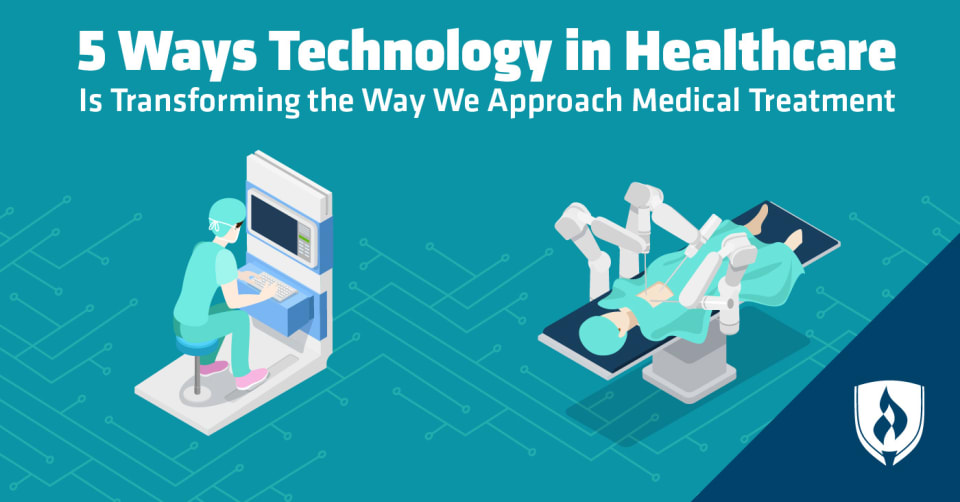5 Ways Technology in Healthcare Is Transforming the Way We Approach Medical Treatment
By Jess Scherman on 05/20/2019

We’ve seen the numerous ways the evolution of technology has impacted everything from our classrooms to our courtrooms, and the healthcare industry is no exception. Doctors and nurses who practiced a century ago would be astonished by our newfound capabilities.
From the invention of infusion pumps and dialysis machines to the creation of antibiotics, heart valves and MRI scanners, technology continues to drive us forward and streamline the way we approach medical treatment. Technology automates and extends things that previously had to be done by people —and that can free medical providers to focus their time and efforts elsewhere, while also potentially reducing the overall cost of medical care.
“Technology has done a lot to improve both our understanding of complex medical and physiological issues, as well as decrease the barriers to delivering care directly to patients,” offers Rafael Salazar II, occupational therapist and president of Rehab U Practice Solutions. “Whether it is telehealth allowing clinicians to interact with patients in different locations or the cost of medical and diagnostic imaging decreasing, technology is helping to improve the overall access to and quality of care.”
We spoke with Salazar and a number of other medical and technology professionals to learn some of the most prominent ways technology in healthcare is making an impact on today’s medical system. Read on to see what they had to say.
Technology in healthcare: 5 ways we’re transforming modern medicine
The healthcare industry has evolved immensely over the years, and much of that change has been driven by technology. Here’s a taste of the changes powered by tech.
1. Electronic health records
“Over the years, advancements in technology have improved the way healthcare professionals approach medical treatment in several key ways,” says Chris Wiegand, co-founder and CEO of Jibestream. Among the most prominent, he points out, is the introduction of electronic health records (EHRs).
The now-antiquated process of using paper filing systems to log patient records made it difficult for clinicians practicing in different facilities to collaborate when it came to patient care. 2009’s Health Information Technology for Economic and Clinical Health (HITECH) Act helped encourage healthcare facilities to streamline their patient record systems by adopting the use of EHRs. While the healthcare system at large is still working through existing roadblocks related to interoperability, EHRs enable providers to streamline many aspects of patient care.
“EHRs are changing the face of global healthcare by providing medical professionals with a fuller, more holistic picture of a patient’s health history, enabling them to make more nuanced decisions regarding their treatment,” Wiegand explains.
Sameer Bhargava, who serves as the chief information officer and chief technology officer at Caregiver, Inc., highlights the efficiencies provided by EHRs to be of critical importance. Over the course of an eight-month period, his team migrated eight million records from paper to an EHR system. “Moving to electronic records elevates our care ecosystem into a cohesive process that can provide a better network of services,” Bhargava says.
“Records provide proof of care to support billing without having to fill out forms or faxes. Auditor surveyors can read proof of service details without searching through cumbersome binders. Orderly incident reports can be assessed and, if needed, appropriately and quickly escalated,” he elaborates. “Issues are handled quickly, by the right person, at the right time. Results include improved quality and safety within a better network of services.”
2. Personalized treatment
Another way technology is driving our healthcare system forward is in its ability to increase patient engagement through the use of devices and wearable technology. Such devices, explains Zillion CEO Brent Wilkinson, can provide insight to help create hyper-targeted, personalized health and wellness plans.
“The personalization can be very precise and can be accomplished through analyzing individuals’ data and presenting care, coaching and health recommendations that precisely address their set of conditions, goals and lifestyle,” Wilkinson explains. “Instead of offering a canned set of content that fits a broad solution to a health system, it’s important to understand the individual and their specific motivations, providing solutions that are particular to their lifestyle in small, manageable steps.”
Wilkinson adds that targeted steps can be helpful for people across the range of healthcare needs: whether you’re perfectly healthy and want to remain that way; you’re positioned between healthy and sick and want to prevent the onset of chronic conditions; or you are currently managing chronic conditions.
3. Telehealth
Telehealth, which includes virtual healthcare, uses technology to improve the efficiency of communications between healthcare providers, clinics and patients. “Technology in the form of electronic communication methods allow clinics, clinicians and patients to exchange information, monitor and track adherence to plan of care and ensure optimal engagement throughout the healthcare process,” Salazar says.
This use of digital communications modernizes the healthcare experience by enabling access to healthcare services remotely, whether it be a patient contacting a clinician in a different area or multiple healthcare providers collaborating with one another from a distance.
“Technology like telemedicine is transforming healthcare by bridging the divide between providers and their patients,” explains Lisa McLaughlin, co-founder and CEO of Workit Health. “It’s no longer necessary to sit in an Urgent Care waiting room for hours on the weekend—telehealth solutions are improving accessibility and convenience.”
But the benefits of telemedicine can stretch far beyond efficiency and convenience for the average patient experience—it can also cut costs and may someday be able to take preventative care to the next level. “Quick communication between patients and providers via an app streamlines the patient experience and saves clinicians and their office staff time,” McLaughlin adds. “In the future, expect to see tech identifying and assisting at-risk patients for earlier interventions.”
4. Surgical technology
Dr. Charlie Chen is a plastic and reconstructive surgeon who is very active in the technology sphere—an important factor for a doctor who is often in an operating room in which technology now plays a prominent role. “I believe we already live in a world where technology now goes hand-in-hand with medicine, ranging from pre-operative planning to performing surgeries to monitoring outcomes,” he says.
Dr. Chen offers a few examples: “We perform virtual 3D reconstructions in our trauma patients, which help guide us where to make the most accurate incisions or bony reconstruction with plates. We can review these images beforehand without making a single incision to plan our surgeries,” he says. “Another example is using infrared technology to monitor blood flow in our flaps, which are used in breast or head and neck cancer reconstruction. Implantable devices are also available that send real-time blood flow data directly to our phones.”
In the wake of the advancements brought on by telemedicine, Dr. Chen sees this as only the beginning of our capabilities with surgical technology, citing the possibility of things like robotics that can be virtually controlled by surgeons who are not directly in the operating room.
5. Artificial technology & augmented reality
In many cases, the combination of two evolving technologies will only open up more possibilities when it comes to medical treatment. “Artificial intelligence is on a crash course with augmented reality, especially in the healthcare space,” offers Adnan Raja, vice president of marketing for Atlantic.net, a web hosting solution that provides HIPAA-compliant, managed and cloud hosting.
For example, Raja suggests that these complementary technological capabilities could equip medical personnel with advanced features, such as X-ray vision and heat-sensing abilities. “Rather than replacing humans with machines, these technologies provide a new way to enhance the ways that machines and humans work together,” he says. “They can improve design speeds and reduce the amount of time it takes for a product to get to market by erasing the need for a physical prototype. It also improves safety and compliance efforts.”
He highlights existing tools that use artificial intelligence and augmented reality, such as AccuVein—a handheld device used by nurses and doctors to scan a patient’s body to make veins visible. Such a tool can greatly improve accuracy when it comes to blood draws or IV insertions, minimizing the likelihood of having to stick a patient multiple times.
“After decades of slow progress, artificial intelligence and machine learning have found their true calling for large-scale success in the fields of healthcare science and advanced research,” Raja explains. “The massive scale needed for the algorithms that drive medical and pharmaceutical research—not to mention the big budgets behind them—is the perfect environment for growth.”
Keep up with the latest trends in healthcare
While our healthcare system has come a long way thanks to the litany of benefits enabled by technology, it’s clear that this is only the beginning of what’s in store for technology in healthcare. From streamlining the patient care process and cutting costs to developing groundbreaking medical capabilities and breakthrough treatment opportunities, our digital age has an array of possibilities that await within the medical world.
If you’re fascinated by news, advancements and even career possibilities related to healthcare, you can stay up to date on the latest by following the Rasmussen College Health Sciences blog. For even more updates, be sure to check in with the Rasmussen College School of Health Sciences on Facebook.




